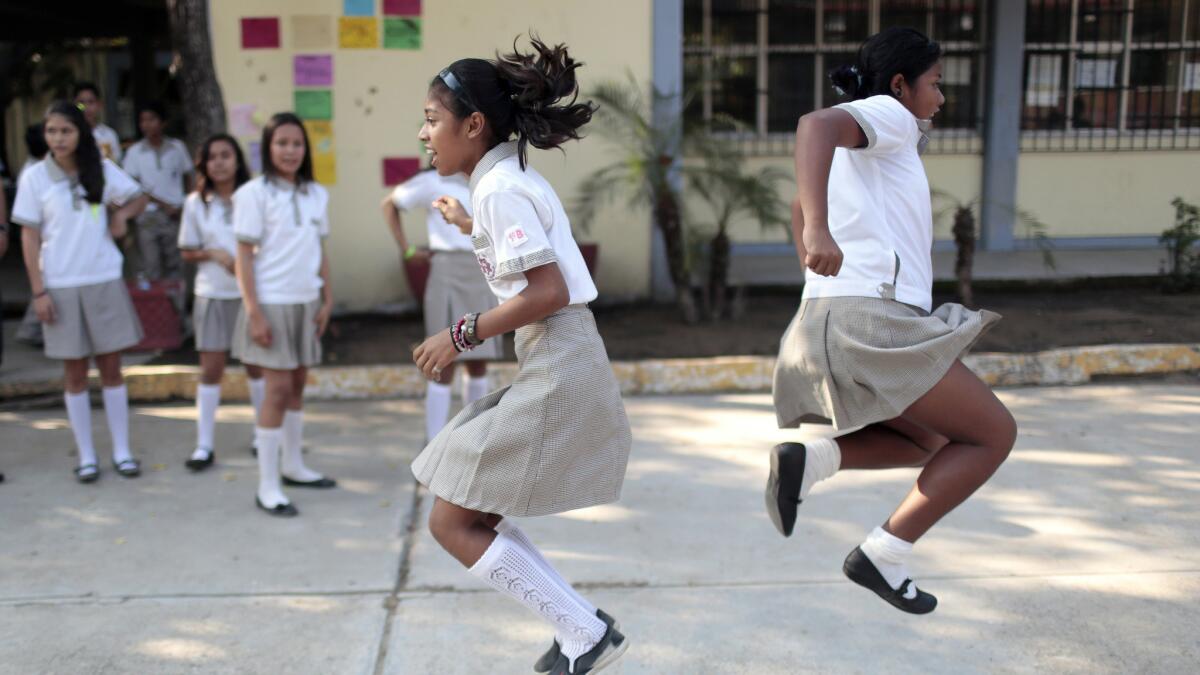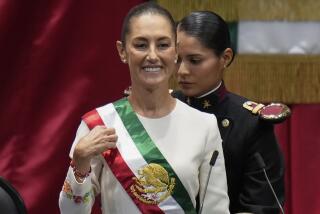Nearly half a million U.S. citizens are enrolled in Mexican schools. Many of them are struggling

Reporting from MEXICO CITY — Two decades ago, a team of U.S. and Mexican researchers descended on Dalton, Ga., to study the growing number of Mexican immigrants who had come to work in the city’s carpet mills.
Victor Zuñiga, a sociologist at the Monterrey Institute of Technology and Higher Education, was interested in what the demographic shift meant for local schools, so he sat down with a teacher who told him something he couldn’t get out of his head.
For the record:
9:15 p.m. Sept. 14, 2016A previous version of this article said Victor Zuñiga is affiliated with the University of Monterrey. He is with the Monterrey Institute of Technology and Higher Education.
“The problem with Latino students,” she said, “is they disappear.”
Zuñiga returned to Mexico intent on finding out what had happened to those kids, many of whom had left the U.S. after family members were deported.
What he discovered was troubling: Many students struggled to integrate into Mexican schools because they couldn’t read or write in Spanish. Others weren’t in school at all because they lacked the necessary accreditations. In all, nearly a third had either been held back a grade or had missed a year or more of school.
“They suffer so much humiliation,” Zuñiga said. “They are invisible.”
This week, Zuñiga joined more than 100 academics, advocates and lawmakers from both sides of the border in Mexico City for a symposium on the issue organized by UCLA. The conference was called: “The Students We Share.”
On the grounds of a 19th century mansion owned by the university on the city’s verdant south side, researchers presented a series of staggering statistics to an audience that included a White House education advisor, Mexico’s deputy secretary of education and a group of elected officials from the California Legislature.
Nearly half a million children who are U.S. citizens are enrolled in Mexican schools, according to the Mexican government. And there are at least another half a million Mexican-born young people who spent part of their life in the U.S. who have now returned home, according to estimates.
Most of the students educated in the U.S. and now living in Mexico are clustered in the northern border states, including Chihuahua and Baja California, said Monica Jacobo, a researcher at the Center for Research and Teaching in Economics. About half of elementary school-age children born in the U.S. arrive in Mexico without the necessary identity documents to enroll in school, she found, and many end up missing class or even entire grades while their parents scramble to obtain the paperwork.
“Mexico is failing us,” said Maggie Loredo, a 26-year-old translator who lives in the central Mexican state of San Luis Potosi.
Loredo was born in Mexico but moved to Georgia with her parents illegally at age 3. By the time she was 18, she realized she couldn’t get a driver’s license, apply for college scholarships or legally work in the U.S., and decided to return to a country she barely knew.
Loredo didn’t apply for Mexico’s public universities because she couldn’t pass the entrance exams, which require written Spanish and a knowledge of Mexican history. The private school she sought to attend wouldn’t accept her U.S. high school transcripts.
“We often feel like foreigners,” she said. “We need programs that will help us adapt in our country. We need resource centers for deportees and returnees at universities. Why not support us with scholarships and leadership programs?”
“These kids we’re talking about have enormous potential, but we’re losing them,” said Patricia Gandara, the UCLA education professor who helped organize the conference. “We want to reframe these kids as bilingual, bicultural assets as opposed to problems.”
The responsibility lies with the U.S. government, as well as with Mexico, Gandara said.
“Many of these [students] are U.S. citizens, and a lot of them will come back,” she said. “We can’t just wash our hands of them while they’re in Mexico.”
The focus of the conference was not only to bring to light the challenges of return migration, but also to devise solutions.
Most agreed that increasing bilingual education on both sides of the border is a good way to start. Students in Mexico who attended school in Texas, where bilingual education is common, adapted better than those who attended school in Arizona, where voters passed a ballot measure limiting the use of Spanish in the classroom, said Rocio Inclan, director of the office of civil and human rights at the National Education Assn.
Mexican officials also spoke of the need to increase the amount of English spoken at Mexican schools. In an interview, Javier Treviño, Mexico’s deputy secretary of education, said he would like to see young returnees be trained as teachers, to help shore up the sparse ranks of Mexican teachers who speak English.
“They have the right to education, and we have the duty to provide it,” Treviño said.
Many at the conference called on Mexico to do more to ease the burden on returning or U.S.-born students. Although the Mexican government recently changed requirements that once forced students to have all U.S. identity documents and diplomas “Apostilled,” a lengthy and cumbersome certification process, many schools continue to refuse to accept transcripts and other documents from U.S. schools, meaning some students end up having to repeat grades.
Thanks to increased border security, an increase in deportations and fallout from the Great Recession, more Mexican immigrants have returned to Mexico than have migrated to the U.S. in recent years.
From 2009 to 2014, 1 million Mexicans and their families left the U.S. for Mexico, according to a Pew Research Center. During the same period, an estimated 870,000 Mexican nationals left Mexico for the U.S.
One in 4 ninth-graders in Mexico had a parent who migrated to the U.S. at some point, according to a study presented by Brian Jensen, an assistant professor at Brigham Young University.
What happens to those who return is an area of study that has long been overshadowed by research into immigrant life in the United States.
But the issue isn’t going away anytime soon, said Jill Anderson, an independent researcher and activist who co-wrote a book of stories of return migration called “Los Otros Dreamers,” or “The Other Dreamers.”
“Because they’re children, this is like a 20-year public policy issue,” she said.
Twitter: @katelinthicum
To read the article in Spanish, click here.
More to Read
Sign up for Essential California
The most important California stories and recommendations in your inbox every morning.
You may occasionally receive promotional content from the Los Angeles Times.











